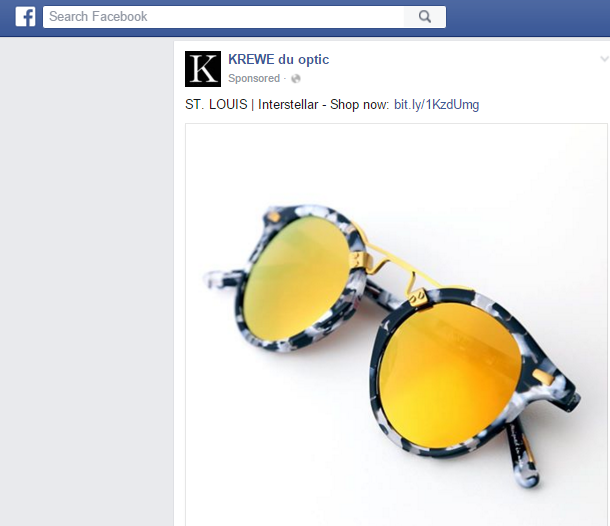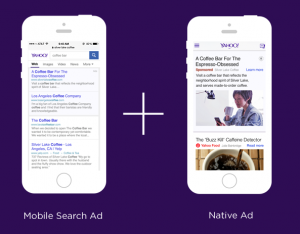Why Retailers Should Focus on Brand Lift


Sometimes retailers make the mistake of focusing so much on ROI, where every dollar and every click must drive to a conversion, that they forget to set their sights beyond the return. Unfortunately, this mindset can be very limiting for businesses in terms of growth.
Brand lift is defined as an increase in the interaction with a brand as a result of an advertising campaign, and is primarily used to identify a positive shift in customer awareness and perception. Retailers use brand lift strategies to build up their presence in the market.
 “There are many different things retailers can do to expand their brand presence on Google including Gmail ad placements, non-branded keyword terms and YouTube videos,” Kristan Ostrom said.
“There are many different things retailers can do to expand their brand presence on Google including Gmail ad placements, non-branded keyword terms and YouTube videos,” Kristan Ostrom said.
“There is a lot of value in growing a business and those types of channels can target based on gender, behavior, interests, competitors, etc.”
If you’re not sure where to start, below we outline 5 potential channels to expand your audience and extend brand lift marketing.
Although social media may not be the first place people go to shop, it has become a source of rapid customer acquisition thanks to advanced targeting capabilities that help to complete the loop for consumers with an interest in your company, brand or type of products.
Using Facebook Ads helps retailers reach their local and extended audience, everyday and everywhere. Facebook advertising is a must have for any business or brand trying to engage with new (or existing) customers. Understanding the Facebook market and it’s advertising platform’s best practices can help retailers maximize their presence on social media and build credibility.
In a recent study, it was determined Facebook ad clicks are increasing 70% year over year, and ad click-through rates are increasing 160%. The lowest hanging fruit for advertisers will be remarketing also known as Facebook retargeting people in their existing sales funnel.
“Facebook is probably the easiest to integrate and get granular with since there are so many people already on the platform and so much data to pull from,” Ostrom said.

The conversion type retailers opt into will largely depend on who they target and the goals of their campaign.
According to our recent social advertising guide, approximately 98% of retailers are going to have to pay if they want to see good results.
While some brands already have a well-developed social strategy, almost all retailers recognize social marketing as a channel of unrealized potential.
Social networks are the hub where consumers come to “hang out” online. When people gather and talk, conversations about products are bound to flourish. More organic and paid social commerce advertising and marketing opportunities are available now than at any other time in history.
In addition to Facebook, retailers can also explore other social networks including Pinterest, Instagram, and Twitter.
Together these social networks represent over 1.5 billion monthly active users – which is just the kind of exposure brands will need to continue to advance their business in 2016.
Since it’s founding in February 2005, YouTube has gathered billions of users to the platform to discover and share videos. It has also become a platform for brands, creators and users to connect with each other – whether it be through entertainment, popular “how to” videos or product reviews.
According to YouTube, product review videos are up 40 percent in views since last year. A Google consumer survey also discovered that one in every five (18 to 24-year-olds) say they go to YouTube to figure out what products or items are “cool” to purchase.
With over 4 billion views every single day, YouTube is quickly becoming the new revenue stream for retailers to advertise and promote their products, along with other forms of social commerce including Facebook and Instagram (which we mentioned above).
Thanks to the introduction of advertising efforts such as TrueView and Google Shopping Ads on YouTube (available through the AdWords interface), retailers are just beginning to scrape the surface on video advertising.
For example, if someone is searching for YouTube videos on yoga positions, an athletic apparel retailer would want to target those videos with a text overlay or a pre-roll ad. These types of advertisements retailers can target based off of the content of the video.
“This is another great way to get in front of people who don’t already know your brand,” Ostrom said.
Google’s Brand Lift Program
In this article, we reference brand lift as a concept but Google does have an actual program available to retailers called “Google Brand Lift“.
Google’s Brand Lift program is typically utilized by big spend retailers to measure video (YouTube) engagement metrics including watch time, views, likes, shares, and comments.
Google uses this type of information to provide a basic barometer showing how an audience responds to videos. However, the effectiveness of an ad campaign is also evaluated by how it affects brand metrics. The goal of the program is to measure the direct impact a retailer’s YouTube ads are having on perceptions and behaviors throughout the consumer journey.
Together these metrics help to gauge lifts in brand awareness, ad recall, consideration, favorability, purchase intent, and brand interest.
In general, when using brand lift efforts (specifically in video) retailers should be asking several questions including:
Google gathers video engagement data in two different ways including:
1. Surveys:
About a day after seeing (or not seeing) your ad, Google delivers a one-question survey to both groups (those who saw your ad and those who did not). Since the only effective difference between the two groups is whether they saw your ad, Google can accurately determine the lift attributed to your campaign.
2. Search:
Brand Lift will also measures the impact your campaign has on creating interest in your brand by using organic searches on both Google.com and YouTube. Similar to surveys, Google randomly pick a group that saw your ad and a control group that didn’t see your ad. They compare the organic search behavior of both groups, looking at how often they search for keywords related to your brand or campaign. The difference in searches can be attributed to your campaign.
Gmail Sponsored Promotions was in beta for a couple years before it’s official release last March. GSP advertisements appear in personal Gmail boxes (usually under the promotions tab). As far as we have seen, the ad type is not used to target Google business email boxes.
GSP features two ad types including a teaser ad and a larger expanded ad unit. The teaser has a 25 character text headline and 100 characters of body text. There is also a 50×50 image and the name of the retailer (or company).
Since Gmail ads track recent email history (the last 300 emails in your Gmail inbox), retailers can serve an ad based on a potential customer’s recent activity.
“For example, if you were planning a wedding – retailers could look at your email history and serve an ad for bridesmaid dresses,” Ostrom said.
The promotion functions on a CPC basis, so retailers only pay for the ad when a customer decides to click on the promotion. Usually, when a customer clicks the ad it will expand into a html featuring additional information such as a form fill out, images, text, links, embedded videos, or click-to-call phone numbers.
Pro-Tip: GSP targeting has all the same functionality as the Google Display Network (GDN) campaigns, and also includes additional targeting capabilities based on job title targeting, purchase history and domain targeting.
When marketers choose to use non-branded keywords they can target shoppers who don’t already know their brand.
For example, a fitness tracker bracelet may want branch out to other areas such as “Valentine’s Day Gifts” especially during the month of February. Non-branded keywords may not get as much of a direct response (conversions, CTR) but retailers are still reaching more people than before.
“It’s not as targeted, so you can’t measure success in the same way, but we are seeing an increase in consumers searching for our branded terms as we start to experiment with non-branded keywords,” Ostrom said.
Yahoo Gemini ads harnesses the powers of mobile search and native advertising into one unified, self-serve solution. By bringing search and native ads together, Yahoo Gemini allows retailers to manage and optimize their ads in one place.

While clearly marked, native ads look and act just like other content on any given page. When advertising appears naturally in content of any kind, it can create a seamless experience for users, increase engagement and improve performance for advertisers.
Sponsored Native ads on Yahoo Gemini mobile search appear where people search for things on tablets and smartphones, and where people read the news, check email and search across desktops, tablets and smartphones.
“A big part of Yahoo’s service offering are these native ads. A lot of people go to Yahoo to consume content. Native ads appear across the Yahoo Network and retailers can target users based on keywords, interests, or behavior. For example, if someone is reading an article about health and fitness – you can target them with an ad for running shoes. You can also access a variety of categories, based on the content. Native ads look a lot like a live article and are similar to Display, but I would say they are more integrated,” Ostrom said.
 It’s important to outline your goals and understand your target marketer before implementing a brand lift strategy. You might want to ask yourself – What are we after? Is it sales, acquiring new users or increasing email subscribers? Ultimately, determinging your priority goal(s) is going to directly impact the brand lift strategy you choose.
It’s important to outline your goals and understand your target marketer before implementing a brand lift strategy. You might want to ask yourself – What are we after? Is it sales, acquiring new users or increasing email subscribers? Ultimately, determinging your priority goal(s) is going to directly impact the brand lift strategy you choose.
“For example, think about how many people are on Facebook. You don’t want to target all of those people. You need to understand your audience and of those millions of people on Facebook – which ones do you care about reaching.
A great way to prepare, is to research your target audience using Google Analytics, Auction Insights (on Facebook). You want to look at the back end first to see who is purchasing your products. Sometimes it’s obvious, but often there are additional markets you are qualified to do well in but not interacting with yet because you lack a brand lift strategy.
Once you have identified your audience, Ostrom recommends to start small and test out a variety of channels and audiences. You should also be testing different creatives within each audience (or channel) before scaling up.
Keep a close eye on the data, rather than making any kind of personal judgements on what is likely to success. Let the data guide you and pay attention to engagement metrics such as CTR or if a shopper watched a 100 percent of your video ad rather than skipping after the 5 second mark. These details will help you gain a better understanding of your audience – and help guide your marketing and branding efforts down the road.
Check back soon for Part 2 of our Brand Lift series – where we dive into more detail on how to measure specific brand lift engagement metrics and what kind of impact those metrics can have on your campaigns.

Notifications